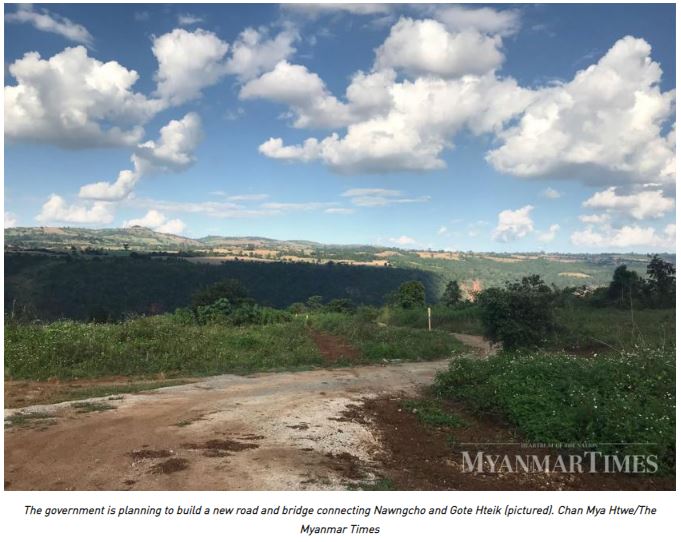Bridge project expected to boost China-Myanmar trade
The construction of a new road and bridge near the existing Goke Hteik railway viaduct in western Shan State will begin this year, the Ministry of Construction has announced.
The major infrastructure project along the Mandalay-Muse road, a significant border-trade route, is expected to significantly boost the transportation of goods between China and Myanmar once it is completed.
The Gote Twin section of the road between Nawngcho and Goke Hteik, along the Mandalay-Muse road, was built during colonial times and the rail bridge on the route is now over 100 years old.
The road is also narrow and has many curves and turns. Currently, trucks can take up to three hours to travel the Goke Twin stretch. During the rainy season, trucks can skid and cause traffic jams, said U Sai Kyaw, general secretary of Rice Merchants Association of Mandalay, adding that the stretch is one of the areas that see the highest number of accidents in western Shan State.
“Whenever an accident happens along the Gote Twin stretch, traffic congestion as long as six to 10 hours can occur, seriously delaying the flow of goods,” U Sai Kyaw said.
Second road, bridge
To solve the issues, the government is planning to build a new road and bridge connecting Nawngcho and Gote Hteik, the ministry said.
The Ministry of Construction, local company Oriental Highway Co, China Harbour Engineering Co Ltd, and China Communications Construction Co Ltd, will build the project, expected to cost more than US$100 million (K152.2 billion) on a build-operate-transfer (BOT) basis.
China Harbour Engineering Ltd will build the new Goke Hteik bridge while Oriental Highway will build the road portion of the project.
The bridge, crossing the Nam Pan stream along the Nawngcho- Goke Hteik road section, will be 887 metres long. The design will feature cable stays and four lanes for vehicle traffic.
The total length of the road and bridge will be 19.3 kilometres shortening the existing route by 6.8 kilometres. As the new road will have better surfaces and fewer sharp curves, traffic congestion and accidents are expected to be greatly reduced, the ministry said, adding that travel time along the stretch is expected to be shortened by at least 45 minutes once the work is completed in 2022.
“Oriental Highway Co maintains the Mandalay-Lashio-Muse road section and has expanded the Kitkai-Muse route to four-lane road on a BOT basis, but the road can still be dangerous currently because the Goke Twin section has not been improved yet,” said U Win Aung Khant, chair of the Muse Highway Freight Forwarders Association.
 The existing Goke Hteik bridge is now over 100 years old. Chan Mya Htwe/The Myanmar Times
The existing Goke Hteik bridge is now over 100 years old. Chan Mya Htwe/The Myanmar Times
About time
“The project should have been started earlier. The cost and time it takes for vehicles to travel this road amounts to losses for the country. We just want it to be finished as soon as possible,” said Mandalay oil merchant U San Tun Lwin.
Although small trucks with loads of up to 17 tonnes used to be allowed on the Mandalay-Muse road in the past, the government has lowered the limit to 15 tonnes in order to reduce stresses on the bridges along the road, he said.
As the Goke Hteik bridge project is of great importance to the country’s trade and commerce, people in the business community are urging that it built according to international standards.
“In the construction sector, Myanmar lacks certain modern capabilities, so it is advisable for the country to implement the project with the aid of modern technology, and it is necessary to strictly include the durability of the bridge in the contract,” said U San Tun Lwin.
“There were bridge projects with flaws under the former administration and if the current government can clamp down on corruption, Myanmar could possess bridges of global standards,” he added.
“There must not be any weakness in terms of the bridge’s strength. I welcome this project. Whether the construction companies are from China or South Korea, I want to see the development of our country without only looking to the profits,” he said.
Myanmar has ratified to join the Economic Corridor project which is a part of China’s Belt and Road Initiative (BRI). The Economic Corridor project includes railway and road projects that will pass through Myanmar.
More growth
With the recent policy changes and investments in infrastructure from BRI, Myanmar is forecast to enjoy a robust economic growth from a regional and global standpoint,” analysts from Singapore’s OCBC Bank wrote in a recent report to its brokerage clients.
Some of the BRI projects are already starting to roll in. After more than two years of negotiations, the government and China’s state-owned CITIC Group on November 8 agreed to proceed with the construction of a deep-sea port in Kyaukphyu, Rakhine State, as part of the BRI.
Another BRI project includes the construction of the Muse-Mandalay railway line. This project aims to connect Ruli East Railway Station in China to Muse, Larshoe, Kyaukme, and Pyin Oo Lwin in Mandalay with 43.5 kilometres of railway track. A feasibility study for the project is expected to be completed this year.
“These BRI projects can help to improve connectivity within Myanmar and with the region, and have the potential to achieve positive spillover effects on trade opportunities if barriers on trade facilitation are overcome,” OCBC said.
China’s investments in Myanmar are coming onstream at a time when FDI appears to be waning. During the first half of this year, approved FDI totaled just US$1.7 billion compared to US$4.1 billion during the same period in the previous fiscal year.
Source: https://www.mmtimes.com/news/bridge-project-expected-boost-china-myanmar-trade.html


 Thailand
Thailand




